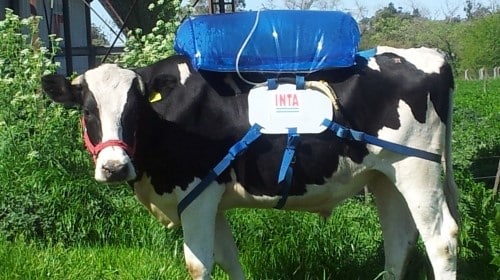A backpack on the backs of cows created to collect the gases produced during the digestion process, allowing for the production of biofuel.
Have you ever imagined a cow carrying a backpack on its back? And with a tube connected directly to one of its four “belly”? That’s exactly what a team of Argentine scientists intend to do: collect cow burps. All to help reduce the greenhouse gases that livestock emit.
Energy production, for industrial or transportation purposes, is the main culprit in greenhouse gas emissions, because it still relies heavily on the burning of fossil fuels, such as oil and coal.
But livestock production is also a major contributor to these gases, already accounting for 14.5% of human-caused greenhouse gases, according to a recent report by the Food and Agriculture Organization of the United Nations (FAO).
“As livestock release greenhouse gases into the atmosphere, we propose an economic and practical way to sequester these emissions and use them as an energy alternative,” said Guillermo Pera, coordinator of the Animal Physiology Group at the National Institute of Agricultural Technology (INTA) in Castellar (Argentina) in a statement from the institute.
The capture and use of gases, especially methane, produced by cows, has been tested by INTA researchers to reduce greenhouse gas emissions and contribute to the production of biofuels, an alternative energy source to fossil fuels. A solution of particular importance in a country like Argentina, one of the world’s largest consumers and exporters of beef.
Experimental device
The FAO report stresses the importance of mitigating greenhouse gas emissions in livestock production: 45% are emitted during food production for animals and 39% are related to gases released by the animals themselves as a result of digestion. Beef and milk production account for 65% of the gases in total livestock production.
During the digestion process in cows and other ruminants, food is forced to pass through several chambers, in order to improve the digestion of dietary fiber. In the first chamber, the rumen, the digestion of cellulose (a complex sugar, a component of plants) begins, where various microorganisms break down the plant cell walls.
The basic compounds of the animal product, which will be absorbed or passed on to the next compartment, the network. Gases such as methane and carbon dioxide are then released.
Reuters reports that INTA has developed an experimental device that directs gases directly from the rumen to the tank. It consists of a system of valves, pumps and tubes connected to a plastic backpack attached to the animal’s back. The tube connecting the rumen requires only a 2-millimeter incision, and under anesthesia, and the backpack weighs no more than 500 grams.

300 liters of methane per day
“Depending on the diet and the size of the animal, an adult cow can produce 1,200 liters of gases per day, of which 250 to 300 are methane,” says Guillermo Pera.
These gases obtained will undergo a purification process: carbon dioxide and hydrogen sulphide are removed, leaving a gas rich in methane, which in turn can be compressed and bottled. “In those places where networks [de energia] “If these products are not enough, producers will have an alternative to cook, light their homes and even fuel their cars,” says Guillermo Pera.
Ricardo Boallo, another researcher on the project, explains what can be done with the roughly 300 litres of methane that cows emit each day: “It can be used to power a 100-litre refrigerator for a day, at a temperature between two and six degrees.”
When asked about ethical issues and animal welfare, veterinarian Guillermo Pera assured that every care and respect for the animals was taken into account and that the cows would have a completely normal life.
[in Publico.pt]




